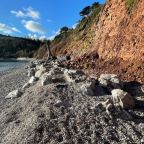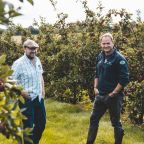
Report provides verdict on Devon’s wildlife winners and losers
Devon’s wild beauty is one of the county’s greatest assets. Its environment provides us not just with amazing landscapes and wildlife but with food, fuel, pollination, flood control and great recreational and business opportunities. It is therefore important that we know how our environment is faring.
These are some of the major conclusions of a newly released ‘stock-check’ on the county’s priority species and the habitats in which they live.
The report called The State of Devon’s Nature, is being launched this Friday (7 March 2014) at a special one-day conference in Cullompton.
The report also showcases the positive differences being made where landowners, farmers, businesses and conservationists are working together to turn around declines in a range of species.
So who are Devon’s wildlife winners and losers of recent years?
Populations of those iconic mammals, otter and dormouse, have remained fairly stable in Devon’s rivers and woodlands. Other species, including barn owl and great crested newt, have not suffered large declines but do face threats such as habitat loss. Targeted conservation efforts have improved the prospects for some creatures, including cirl bunting and southern damselfly, though their future remains challenging.
The Report concludes that the state of some of Devon’s species should concern us. Curlews, although still a regular winter visitor to the county’s estuaries, now no longer breed on Exmoor, and breeding pairs elsewhere in the uplands have severely declined. The high brown fritillary butterfly and the white-clawed crayfish are both in danger of extinction in Devon. Local extinction did befall the popular water vole, ‘Ratty’ in Wind in the Willows, in the late 90s, before a population was re-introduced in east Devon.
Key to the State of Devon’s Nature report is a measurement of the health of the county’s natural landscapes. Here the picture is very mixed.
- Only around a third of Devon’s rivers are in good condition and many are struggling to support a diverse range of wildlife because of pollution, man-made barriers and invasive species.
- With the support of agri-environment grants, Devon’s upland wetlands and heathlands are being better-managed by farmers. However, large areas fail to support the range of birds and insects they once did.
- Devon’s woodlands have not been reduced in size, but do face threats including invasive species like rhododendron, large deer and grey squirrel populations and diseases such as ash dieback.
- As sea levels rise, sand dunes and saltmarshes are coming under greater pressure where coastal development prevents their retreat inland.
- Devon’s sea life remains threatened by damaging fishing practices such as bottom-trawling, by climate change and pollution.
However the Report also shows the depth of feeling that many people have towards wildlife in Devon. Indeed, the State of Devon’s Nature pays tribute to the efforts of an army of willing volunteers who have lent their expertise to gathering its data.
The Report is also positive about the many places in Devon where groups and individuals have been working together to improve the natural environment.
Advice and agri-environment grants provided to south Devon farmers have improved habitat for cirl buntings and other farmland wildlife. Commercial business, conservation land managers and farmers are working in partnership in north Devon’s Culm grasslands. Here, wildlife habitat, water quality and flood alleviation are all being improved through the Upstream Thinking project funded by South West Water.
The Report acknowledges the part being played by legislation in producing benefits for marine wildlife.
In the No Take Zone around Lundy Island, lobsters are now five times more abundant and individuals 9% larger than in surrounding waters. The Northern Devon Nature Improvement Area is also a prime example of the new mood of partnership working.
An array of organisations led by Devon Wildlife Trust is working with local communities and landowners to improve the quality of habitats and water in the River Torridge catchment. What’s more, the project is linking physical health, mental well-being and cultural richness to the quality of Devon’s natural environment and the enjoyment it brings to residents and visitors alike.
The Devon Local Nature Partnership, Natural Devon, is the umbrella body behind the State of Devon’s Nature report. Natural Devon’s aim is to get everyone in the county to work better together to ensure the protection of Devon’s wildlife, not just for its own sake but because it underpins our high quality of life.
Chair of the Devon Local Nature Partnership is Suzanne Goodfellow. Formerly Director of Conservation at Dartmoor National Park Authority, she stressed the importance of partnership working: “Devon is a wonderful place for people and wildlife! And Natural Devon is in the business of bringing them together for their mutual benefit.
"We now have a great partnership of environmental, health, community and economic organisations working together to connect people and nature.”
TV wildlife-presenter Nick Baker will be speaking at Friday’s conference in Cullompton, launching the State of Devon’s Nature report, along with Devon Local Nature Partnership’s own prospectus.
The conference will bring together a broad range of interests – health professionals, farmers, economists, planners and ecologists to discuss how to achieve Natural Devon’s vision for Devon.
Suzanne Goodfellow continued: “Our new prospectus is based on extensive consultation with the people of Devon and sets out our priorities for the next five years.
"At the conference we will draw up a list of actions to help us achieve them. Natural Devon is also today publishing the State of Devon’s Nature report, full of information about Devon’s wildlife from a large number of expert individuals and organisations.
"We thank them for their contributions and hope that the report will be used by everyone to help them to make wise decisions about our natural environment and enjoy finding out more.”











